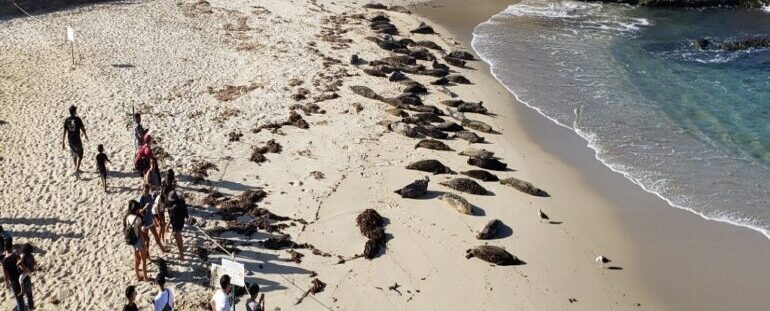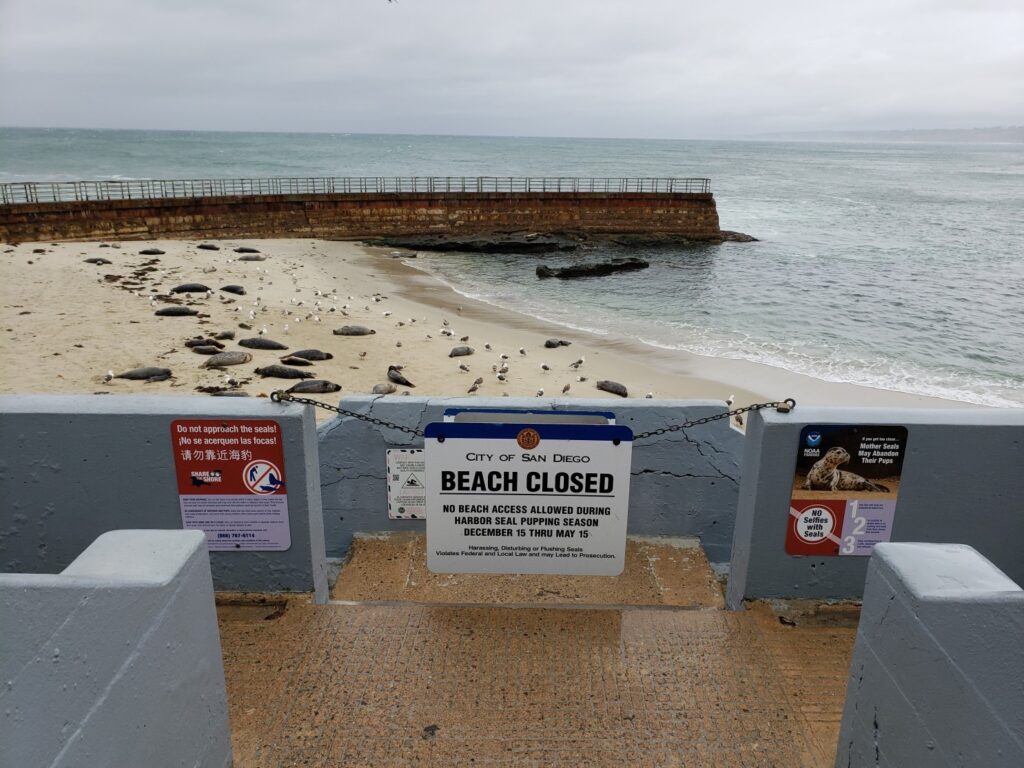
By Lori Mendez with an introduction by Christy Lambert
Seal pupping season is coming to an end in San Diego, which means the annual reopening of Casa Beach/Children’s Pool is upon us! Or is it? SDCBA Animal Law section member Lori Mendez gives us a look into the past, present, and future of Casa Beach/Children’s Pool through the lens of the law. Find her memo here:
The tiny spit of sand called Casa Beach a.k.a. “the Children’s Pool Beach” measures about 200 feet along the water’s edge and no more than 35 feet at low tide from the water’s edge to the back cliff. Its year-round inhabitants (between 160 to 200 harbor seals) have been a magnet for tourists and locals alike, currently bringing around 1.5 million annual visitors drawn to see the seals. This place is also well-known for its long-running Hominid v. Phocidae controversy and conflict.
A Look Back to See How We Got Where We are Today:
An 1887 map of the area references “Seal Rock Pt.” and “Seal Rock” just beyond. Likely seals inhabited this area well over a century ago. However, their numbers were limited as they were hunted almost to extinction and were inundated by people frequenting the beach.

In 1931 La Jolla philanthropist Ellen Browning Scripps donated funds to build the sea wall, and the State, the owner of the tideland, granted a tideland trust to the City of San Diego. That same year in 1931, the State deeded the site to the City of San Diego by a California Tidelands Grant, which stated “Said lands shall be devoted exclusively to public park, bathing pool for children, parkway, highway, playground, and recreational purposes, and for such other purposes as may be convenient for the full enjoyment of such purposes.” In 2009 the State Senate passed SB428, which added an additional use to the Statutes of 1931: to allow Casa Beach to be used as “a marine mammal park for the enjoyment and education of children.”
Starting in around 1972 these creatures began re-inhabiting Casa Beach, a.k.a. “the Children’s Pool” after they received protection from “taking” (killing) and from “harassment, injury and disturbance” under the Marine Mammal Protection Act of 1972 (16 U.S.C. ch. 31 §§ 1361–1362, et seq.) (“MMPA”).
From February 1, 1993 through 2003, the City designated nearby Seal Rock an “Ecological Reserve,” then a “Marine Mammal Reserve” to prevent harassment by swimmers and divers.
Unlike the larger sea lions who reside just up the coast at La Jolla Cove and have stronger flippers and bony pelvic structures that allow them to haul themselves out onto higher rocks, the harbor seals, clumsily inch worm along on land, and much prefer to haul out onto sandy beaches, or low lying rocks. The first seals were observed hauling out on the sand at Casa Beach in 1993, and beginning in 1994, more and more harbor seals began hauling out, residing, molting, birthing, and pupping on Casa Beach.
A Turning Point:
In 1997, there were several instances of Children’s Pool closure due to fecal coliform bacteria counts exceeded state water quality standards. At this point, despite 11 other nearby beaches, local factions started to form when divers and swimmers lost access to ocean beach entry, while other locals became concerned for the welfare of the now well-established seal rookery.
Since, there has been an increase in the population of harbor seals to the current stable population of between around 160 to 200 seals, believed to be limited by the holding capacity that is determined by the size of the beach.
Turmoil and The Dredging Plan:
There was shouting, insults, and death threats as both sides became impassioned and emboldened.
Then, in 1998 District 1 Councilmember Harry Mathis urged the City Manager to apply for a Coastal Development Permit to dredge the beach to have less sand available for the seals to haul out on, and to restore the shared use of the Children’s Pool by people and harbor seals.
In March 1999 the City voted 6-3 not to dredge, not to shoo the seals, but instead to put up a barrier rope to protect humans from seals and seals from humans. A guideline rope along with a City of San Diego sign not to approach the seals or make loud sudden noises were placed from 1999-2004.
In 2003, Scott Peters tried to revive former City Councilmember Harry Mathis’ dredging plan to contend with the “invasion of the seals” and to give the beach back to the children of La Jolla. He directed the City Manager to produce a report with ideas about how to reduce pollution levels at the Children’s Pool for joint use of seals, divers, fishermen, children, and their families.
LET’S GO TO COURT!
But first, Jurisdictional Questions: There are three potential jurisdictions and venues:
Federal jurisdiction: Due to the possible preemption of the Federal MMPA as interpreted by the now defunct Southwest National Marine Fisheries Service (“NMFS”) and the National Oceanic and Atmospheric Administration (“NOAA”);
State jurisdiction: The Public Trust Doctrine granted the state ownership of all tidelands upon its admission into the Union and upon becoming a State on September 9, 1850 (See the act of March 28, 1868, fn. 6 entitled “An Act to provide for the management and sale of the lands belonging to the State” and see also Marks v. Whiney (1971) 6 Cal.3d 25, expanding that Doctrine.) The Public Trust Doctrine restricts the use of sovereign lands to public trust purposes, such as “navigation, fisheries, commerce, public access, water-oriented recreation, open space and environmental protection.” Additionally, the 1988 Local Coastal Program “LCP” for La Jolla segment is administered jointly by the City and the California Coastal Commission to guide development in the coastal zone; and
Municipal jurisdiction: Established in the 1931 State Tideland Trust deeded the right and title to the Children’s Pool from the State to the City of San Diego to be held in trust for public use. (Statute No. 937 signed by the governor on June 15, 1931.)
Conflict and Controversy Continued to Escalate from 2004 through 2019:
The issues of the erection of the guide rope and beach closure were tossed around back and forth upon a turbulent sea of several different jurisdictions (city, state, and federal) and multiple venues, including the legislature (City Council and the State Legislature), Federal Administrative (the now defunct Southwest National Marine Fisheries Service (NMFS) and the National Oceanic and Atmospheric Administration (NOAA), and the courts (San Diego Superior Court and Orange County Superior Court, California 4th District Court of Appeal, San Diego District Court and the Federal 9th District Court of Appeals.)
Some Highlights:
In August 2005, San Diego Superior Court Judge William C. Pate ordered dredging of the Children’s Pool to disperse the seals. The opinion was appealed first to the California 4th Circuit Court of Appeal and then to the State Supreme Court, where Judge Pate’s ruling was upheld in November of 2007.
In 2008, Animal Law Section member Bryan Pease filed a case on behalf of the Animal Protection and Rescue League in the District Court unsuccessfully arguing federal preemption.
Then in 2009, after the dust had settled on all state and federal court pending appeals, Superior Court Judge Yuri Hoffman held that the City was in contempt of Judge Pate’s ruling and needed to dredge.
On June 8, 2009, Former Judge, and then City Attorney Jan Goldsmith wrote a memo laying out the impracticality of the nearly $2 million dredging proposal. Mr. Goldsmith recommended that the City ask the state legislature to introduce new legislation to give the City discretion on the use of the beach. Senator Christine Kehoe did so, and Senate Bill 428 was signed into law on July 20, 2009. That bill added the phrase “marine mammal park for the enjoyment and educational benefit of children” to the 1931 Tidelands Trust so that it now reads, “That said lands shall be devoted exclusively to public park, marine mammal park for the enjoyment and educational benefit of children, bathing pool for children, parkway, highway, playground and recreational purposes, and to such other uses as may be incident to, or convenient for the full enjoyment of such purposes.” SB 428 became law on January 1, 2010.
In November 2009, San Diego Superior Court Judge Timothy Taylor held that in deference to the passage of SB 428, the seals shall remain at the Children’s Pool, and he terminated the injunction to disperse the seals.
Thereafter, there was back and forth at City Council, Coastal Commission, the Superior Court and Court of Appeal about the installation and length of a permanent guideline rope, beach closure during pupping season, signage and no dogs on the beach.(See San Diego Municipal Code 63.01.02(e) approved by the City Council on February 24, 2014.)
On April 14, 2014, the California Coastal Commission unanimously approved the City’s plan to close Casa Beach for pupping season. The approval of the City’s plan to close Casa Beach during the harbor seal pupping season was for a 5-year period to be revisited in 2019. Likewise, the California Coastal Commission unanimously approved a four-year permit extension to keep the guideline rope up at Casa through 2019.
In October 2014, the Friends of the Children’s Pool filed a lawsuit against the City of San Diego challenging the City’s decision to annually close Casa Beach to people during the pupping season.
On May 3, 2016, Orange County Judge Frederick Horn ruled against the City, finding MMPA preemption, and illegality of the beach closure. The City appealed, and the 4th District Court of Appeal unanimously reversed Judge Horn’s decision, addressing the MANY YEARS OF CONFLICT, and ultimately refusing to reach “such an absurd conclusion” to support preemption (and potentially undoing the resolution supported by public opinion, and that was many years in the making with a culmination of hard work by the City Council and the Coastal Commission with contribution by the State Legislature and also with evolving input from NMFS/NOAA).
Fast forward: Ultimately, signs have been installed, the pup season ordinance has passed and the beach is closed to humans from December 15 through May 15, and there is a permanent guideline rope that is up at all times from May 16 through December 14 when the beach is open for shared use.


Most Recently:
On June 13, 2019, the California Coastal Commission unanimously approved the City of San Diego’s applications to renew the two Seal Protection Permits, allowing the City to continue the successful policy of closing Casa Beach during the harbor seal pupping season (December 15 to May 15 annually), as well as the installation of the guideline rope during the seven non-pupping-season-months. Both Coastal Development Permits are valid for ten years, until June of 2029.
On April 27, 2020, the Sierra Club, San Diego Chapter-Seal Society of San Diego submitted a letter to Mayor Faulconer, City Council Members and other public officials requesting a delay in the opening of Casa Beach/Children’s Pool, La Jolla Point, and Boomer’s Beach due to the COVID-19 crisis, to promote social distancing.
Voltaire said that “perfect is the enemy of the good.” With the implementations of these actions, there seems to be a détente — a lowering of hostilities and voices. The implementation of these measures by the City Council and the Coastal Commission as sanctioned by the Court of Appeal is a win for the seals and their advocates who promote seal welfare, as well as the divers, fishers, and swimmers who can still access Casa Beach during non-pupping season.
For more information, check out:
U-T and La Jolla Light articles referenced in the footnotes at https://en.wikipedia.org/wiki/Children%27s_Pool_Beach
For video of harbor seal pup birth and mom/pup bonding (taken by Lori Mendez), see: https://youtu.be/SPg86LP0ffE
Lori Mendez, Esq., Scripps Institute of Oceanography Master in Biodiversity and Conservation, is a Harbor Seal Pup Season “Talk-and-Walk” docent.